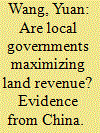|
|
|
Sort Order |
|
|
|
Items / Page
|
|
|
|
|
|
|
| Srl | Item |
| 1 |
ID:
159041


|
|
|
|
|
| Summary/Abstract |
This paper examines how political considerations affect local officials' revenue maximization behaviors in the context of urban land conveyance in China. Particularly, we analyze government intervention based on local officials' choice of two land auction types, namely, “English auction” and “two-stage auction”. The latter presumably serves as a tool of government intervention. We aim to address the research question: “Are local governments maximizing land revenue?” The major findings are threefold. First, for cities with higher housing prices, two-stage auctions are adopted more frequently than English auctions. In addition, land parcels in these “hot” cities adopt two-stage auctions more frequently during sensitive political events, suggesting that local officials respond positively to the real estate regulation policy from central government. Second, when city leaders are more incentivized to promote economic performance, they respond less positively to rises in housing prices. Third, such interventionist behavior results in a significantly depressed land price and housing price. Despite its intention of improving public welfare, this interventionism can susceptibly cause problems of misallocation and corruption.
|
|
|
|
|
|
|
|
|
|
|
|
|
|
|
|
| 2 |
ID:
107519


|
|
|
|
|
| Publication |
2011.
|
| Summary/Abstract |
This study takes a fresh look at the direction of causality between energy consumption and economic growth in China during the period from 1972 to 2006, using a multivariate cointegration approach. Given the weakness associated with the bivariate causality framework, the current study performs a multivariate causality framework by incorporating capital and labor variables into the model between energy consumption and economic growth based on neo-classical aggregate production theory. Using the recently developed autoregressive distributed lag (ARDL) bounds testing approach, a long-run equilibrium cointegration relationship has been found to exist between economic growth and the explanatory variables: energy consumption, capital and employment. Empirical results reveal that the long-run parameter of energy consumption on economic growth in China is approximately 0.15, through a long-run static solution of the estimated ARDL model, and that for the short-run is approximately 0.12 by the error correction model. The study also indicates the existence of short-run and long-run causality running from energy consumption, capital and employment to economic growth. The estimation results imply that energy serves as an important source of economic growth, thus more vigorous energy use and economic development strategies should be adopted for China.
|
|
|
|
|
|
|
|
|
|
|
|
|
|
|
|
| 3 |
ID:
125834


|
|
|
|
|
| Publication |
2013.
|
| Summary/Abstract |
Fossil fuel-related CO2 emissions are regarded as the primary sources of global climate change. Unlike direct CO2 emissions for each sector, CO2 emissions associated with complex linkages among sectors are usually ignored. We integrated the input-output analysis with the hypothetical extraction method to uncover the in-depth characteristics of the inter-sectoral linkages of CO2 emissions. Based on China's 2007 data, this paper compared the output and demand emissions of CO2 among eight blocks. The difference between the demand and output emissions of a block indicates that CO2 is transferred from one block to another. Among the sectors analyzed in this study, the Energy industry block has the greatest CO2 emissions with the Technology industry, Construction and Service blocks as its emission's primary destinations. Low-carbon industries that have lower direct CO2 emissions are deeply anchored to high-carbon ones. If no effective measures are taken to limit final demand emissions or adjust energy structure, shifting to an economy that is low-carbon industries oriented would entail a decrease in CO2 emission intensity per unit GDP but an increase in overall CO2 emissions in absolute terms. The results are discussed in the context of climate-change policy.
|
|
|
|
|
|
|
|
|
|
|
|
|
|
|
|
| 4 |
ID:
103885


|
|
|
|
|
| Publication |
2011.
|
| Summary/Abstract |
The present paper attempts to combine cointegration theory and the material flow analysis approach to examine the causal relationship between resource use and real GDP in Jiangsu Province in East China. The study considers the period from 1990 to 2007. We use direct material input as the proxy variable for resource use. Our estimation indicates that real GDP and resource use are cointegrated and there is only unidirectional long-run Granger causality running from resource use to real GDP, but not vice versa. The estimation results mean that resources are a limiting factor in terms of economic growth, and, therefore, strategies should be adopted for more vigorous economic development and consistent resource use in East China. Furthermore, the novel idea and methodology involved in the present study can be readily extended to cover other regions for the analysis of the relationship between resource use and economic growth.
|
|
|
|
|
|
|
|
|
|
|
|
|
|
|
|
|
|
|
|
|